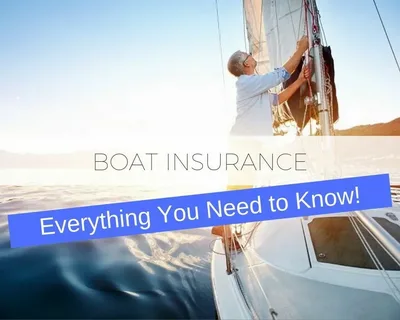Introduction:
Owning a boat is a cherished investment that brings joy, relaxation, and unforgettable experiences on the water. However, with the pleasure of boat ownership comes the responsibility of protecting your vessel against potential risks and liabilities. Boat insurance provides essential financial protection for boat owners, covering damages, liabilities, and other unforeseen events. Boat insurance rates vary depending on several factors, including the type of boat, coverage options, navigational limits, and the owner’s boating experience. In this SEO-friendly article, we’ll explore boat insurance rates in detail, factors influencing premiums, coverage options, and tips for finding affordable coverage to sail with confidence.
Understanding Boat Insurance Rates:
Boat insurance rates refer to the cost of insurance premiums paid by boat owners to obtain coverage for their vessels. Boat insurance rates are determined based on various factors that assess the level of risk associated with insuring the boat and the likelihood of claims or losses occurring. Understanding these factors is essential for boat owners to evaluate insurance options, compare quotes, and find affordable coverage that meets their needs and budget.
Factors Influencing Boat Insurance Rates:
Several factors influence boat insurance rates, including:
- Type and Value of Boat: The type, size, age, and value of the boat are significant factors in determining insurance rates. Larger, newer, and more expensive boats typically have higher insurance premiums due to the higher cost of repairs or replacement in the event of damage or loss.
- Boat Usage and Navigation: The intended use of the boat and its navigational limits can impact insurance rates. Boats used for recreational purposes, fishing, watersports, or cruising in inland waters may have lower premiums compared to boats used for racing, commercial purposes, or offshore navigation.
- Boating Experience and Safety Record: The owner’s boating experience, training, and safety record can affect insurance rates. Experienced boaters with a clean safety record and completion of boating safety courses may qualify for lower premiums due to reduced risk of accidents or claims.
- Location and Mooring: The location where the boat is moored, stored, or operated can influence insurance rates. Boats stored in areas prone to theft, vandalism, or severe weather may have higher premiums, while boats stored in secure marinas or inland lakes may qualify for lower rates.
- Coverage Options and Limits: The types and levels of coverage selected for the boat insurance policy can impact insurance rates. Comprehensive coverage with higher limits and additional protections, such as liability coverage, medical payments coverage, and uninsured/underinsured boater coverage, may result in higher premiums.
Types of Coverage in Boat Insurance:
Boat insurance policies typically include several types of coverage options to protect against various risks and liabilities, including:
- Hull Coverage: Hull coverage, also known as physical damage coverage, provides reimbursement for repair or replacement costs for the insured boat in the event of damage or loss caused by accidents, collisions, sinking, fire, theft, vandalism, or other covered perils.
- Liability Coverage: Liability coverage protects boat owners against financial liabilities for bodily injury or property damage caused by the insured boat to third parties. It covers legal expenses, court judgments, and settlement costs for liability claims arising from accidents or incidents involving the insured boat.
- Medical Payments Coverage: Medical payments coverage provides reimbursement for medical expenses incurred by the insured boat owner, passengers, or crew members in the event of injuries sustained in a boating accident, regardless of fault. It covers expenses such as ambulance fees, hospitalization, surgery, and follow-up care for covered injuries.
- Uninsured/Underinsured Boater Coverage: Uninsured/underinsured boater coverage protects boat owners against bodily injury and property damage caused by uninsured, underinsured, or hit-and-run boaters. It covers medical expenses, lost wages, and repair or replacement costs for the insured boat if the at-fault boater lacks adequate insurance coverage.
- Personal Effects Coverage: Personal effects coverage provides reimbursement for personal belongings and equipment stored on board the insured boat, such as fishing gear, electronics, navigation equipment, and personal effects, in the event of theft, loss, or damage.
Tips for Finding Affordable Boat Insurance Rates:
Finding affordable boat insurance rates requires careful consideration of coverage options, policy features, and risk factors. Here are some tips for boat owners to find affordable coverage:
- Shop Around and Compare Quotes: Obtain boat insurance quotes from multiple insurance providers to compare coverage options, premiums, deductibles, and policy terms. Consider factors such as coverage limits, exclusions, discounts, and customer service reputation when evaluating quotes to find the best coverage at a competitive price.
- Bundle Policies: Consider bundling boat insurance with other insurance policies, such as auto insurance, homeowners insurance, or umbrella insurance, with the same insurance provider to qualify for multi-policy discounts. Bundling policies can help save money on insurance premiums and streamline insurance management.
- Take Advantage of Discounts: Inquire about available discounts for boat insurance, such as multi-policy discounts, safe boater discounts, boating safety course discounts, anti-theft device discounts, and loyalty discounts. Taking advantage of discounts can help lower insurance premiums and save money on coverage.
- Maintain a Clean Boating Record: Practice safe boating habits and adhere to boating safety regulations to maintain
